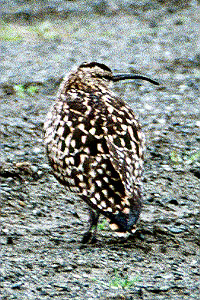Bristle-thighed Curlew (Numenius tahitiensis)
Crescent City, Del Norte County, California
15 May 1998
 Photos © 1998 by Don Roberson. All
rights reserved.
Photos © 1998 by Don Roberson. All
rights reserved.
Upon learning that Alan Barron found a Bristle-thighed Curlew at Crescent City harbor on Thursday, 14 May, I
made arrangements to drive up Friday morning with John Luther in hopes of seeing the bird that afternoon. At 9:30am
we stopped near Santa Rosa, called the Arcata Birdbox (707) 822-5666 and were pleased to hear Alan Barron report
that the bird was still present that morning and had been seen by Guy McCaskie, Bruce Deuel and others.
About 2:30pm we arrived at the foot of "A" street at the northwest corner of Crescent City harbor
to find no other birders present. We scoped out two Whimbrel sleeping on the nearby beach. John spotted a more
distant buffy looking bird on the beach and we drove over to it and studied it in detail. It was similar to the
two Whimbrels but seemed browner and more buffy below. Eventually it flew giving a typical Whimbrel call and showing
the heavily mottled rump typical of Whimbrel. It joined the other two Whimbrels in flight along with four other
Whimbrel-like birds which flew north out of sight. We searched the area north of the harbor with no luck. I left
a phone message for Alan Barron hoping to get information on other places the bird might be. We checked the beach
again when John found three Whimbrel-like birds feeding on the lawn across the street. Two were typical Whimbrels,
but one was larger and buffier. In fact it was probably the same bird we had studied on the beach earlier.
Then Alan Barron drove up and kindly led us to the real Bristle-thighed Curlew which was in a most unlikely place, along the edge of a small empty lot on the west
side of "B" street. Upon seeing the real thing, the identification was obvious. This was a very coarsely
marked bird, with a bright cinnamon colored tail looking very different from the much more finely patterned Whimbrels
we had been studying. The bird was very cooperative and allowed prolonged study through telescopes at very close
range in good light. The sky was overcast, diffusing the sunlight and there was no rain and only light wind. We
studied the bird closely for several hours while other birders arrived, mostly locals who had already seen the
bird. Eventually Mark Fenner and David Yee arrived along with a number of Humboldt County birders (Chet Ogan and
others) and some other people I didn't know. It started to rain while we watched the bird until about 6pm while
David Yee and Mark Fenner attempted photographs.
unlikely place, along the edge of a small empty lot on the west
side of "B" street. Upon seeing the real thing, the identification was obvious. This was a very coarsely
marked bird, with a bright cinnamon colored tail looking very different from the much more finely patterned Whimbrels
we had been studying. The bird was very cooperative and allowed prolonged study through telescopes at very close
range in good light. The sky was overcast, diffusing the sunlight and there was no rain and only light wind. We
studied the bird closely for several hours while other birders arrived, mostly locals who had already seen the
bird. Eventually Mark Fenner and David Yee arrived along with a number of Humboldt County birders (Chet Ogan and
others) and some other people I didn't know. It started to rain while we watched the bird until about 6pm while
David Yee and Mark Fenner attempted photographs.
The bird did not fly during the entire time of our observation, but others said it had flown that morning and
was capable of flight. It drooped its right wing almost the entire time and it had a gimpy left foot which made
it limp slightly. It preened several times allowing clear views of the bright unmarked cinnamon-colored rump. The
following description is based on notes taken while watching the bird:
A medium-large cinnamon brown shorebird with a rather long downcurved bill recalling Whimbrel. the bill was
rather uniformly curved and showed a tiny amount of pink color on the base of the lower mandible. The nostril was
wedge-shaped and extended forward along a nasal groove which stopped about half way out the bill. The lateral crown
stripes were chestnut-brown, connecting across the forehead and contrasting with the pale supercilium which was
light buff with dusky streaks throughout. The pale median line was very narrow. The eye was dark with a broken
white eye-ring above and below contrasting with a narrow dark line forming a forked triangle in front of the eye
and an indistinct stripe behind the eye. This did not contrast strikingly with the pale face which was streaked
throughout, similar to the supercilium. The nape and the side of the neck was coarsely streaked with dusky. The
neck was fairly long and heavily streaked in front, with the streaks extending down across the breast recalling
Pectoral Sandpiper. However the chin and throat were unstreaked contrasting abruptly with the streaked face.
The wings were long with long primary projection. Three blackish-brown primaries projected beyond the tertials
and reached slightly past the tail. The three tertials on the right wing appeared very worn and abraded, but on
the left wing they appeared fresh with pale rounded scalloping along the fringes. On the droopy right wing the
inner primary tips and inner webs were very narrowly fringed white. The outermost primary showed a white shaft,
the other primaries had buffy shafts. The innermost primaries and the secondaries appeared to have pale brown barring
and buff spotting. The underwing coverts were heavily barred, visible only when the bird exposed the underside
of the drooped right wing.
The scapulars were dark centered with large buffy heart-shaped patches on either side of each feather. The wing-coverts
were similarly patterned but with smaller paler markings. The rump was rich cinnamon without bars or streaking.
The uppertail coverts and lower back were also rich cinnamon brown but these areas showed dark bars above and below
the rump proper. The tail was reddish cinnamon with three obvious dark bars.
The underparts were rich buff throughout with obvious dark anchor or open chevron-shaped markings on the sides
of the breast not extending to the flanks. On the thighs, very long whitish bristles extended down past the leg
joint. These were best seen when the bird was standing in front of green vegetation.
The legs were dull whitish-gray with narrow transverse scutes across the front of the tarsus. The toes appeared
rather fleshy with partial webbing.
The behavior of this bird seemed quite peculiar and very unlike a Whimbrel. It spent most of its time creeping
around like a rail, feeding on insects on the grass and small willows. When feeding on the bare dirt, it did not
probe with its bill, but turned its head upside down, and used the tip of the bill like a crowbar to pry up the
dirt. It frequently blinked its eyes very slowly, but otherwise seemed alert. It often cringed when a raven would
fly over, but when calling Whimbrels flew over the Bristle-thighed Curlew seemingly ignored them.
This is the first Bristle-thighed Curlew I have ever seen anywhere. A phenomenal number of Bristle-thighed Curlews
have been reported in Oregon and Washington this week. For a summary and additional interesting photographs see
http://home.pacifier.com/~mpatters/bird/btcu/btcu.html.
Account written 16 May 1998
--
Joseph Morlan
380 Talbot Avenue #206
Pacifica, CA 94044
 unlikely place, along the edge of a small empty lot on the west
side of "B" street. Upon seeing the real thing, the identification was obvious. This was a very coarsely
marked bird, with a bright cinnamon colored tail looking very different from the much more finely patterned Whimbrels
we had been studying. The bird was very cooperative and allowed prolonged study through telescopes at very close
range in good light. The sky was overcast, diffusing the sunlight and there was no rain and only light wind. We
studied the bird closely for several hours while other birders arrived, mostly locals who had already seen the
bird. Eventually Mark Fenner and David Yee arrived along with a number of Humboldt County birders (Chet Ogan and
others) and some other people I didn't know. It started to rain while we watched the bird until about 6pm while
David Yee and Mark Fenner attempted photographs.
unlikely place, along the edge of a small empty lot on the west
side of "B" street. Upon seeing the real thing, the identification was obvious. This was a very coarsely
marked bird, with a bright cinnamon colored tail looking very different from the much more finely patterned Whimbrels
we had been studying. The bird was very cooperative and allowed prolonged study through telescopes at very close
range in good light. The sky was overcast, diffusing the sunlight and there was no rain and only light wind. We
studied the bird closely for several hours while other birders arrived, mostly locals who had already seen the
bird. Eventually Mark Fenner and David Yee arrived along with a number of Humboldt County birders (Chet Ogan and
others) and some other people I didn't know. It started to rain while we watched the bird until about 6pm while
David Yee and Mark Fenner attempted photographs. Photos © 1998 by Don Roberson. All
rights reserved.
Photos © 1998 by Don Roberson. All
rights reserved.